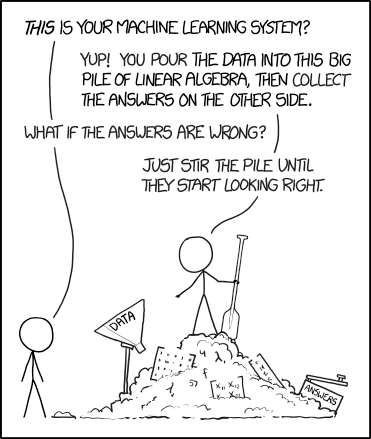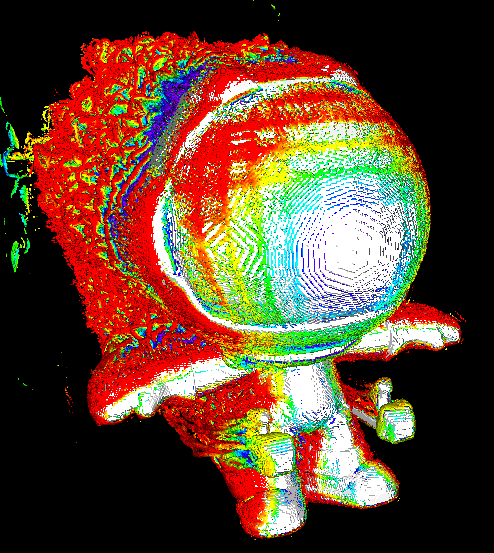The majority of “AI Experts” online that I’ve seen are business majors.
Then a ton of junior/mid software engineers who have use the OpenAI API.
Finally are the very very few technical people who have interacted with models directly, maybe even trained some models. Coded directly against them. And even then I don’t think many of them truly understand what’s going on in there.
Hell, I’ve been training models and using ML directly for a decade and I barely know what’s going on in there. Don’t worry I get the image, just calling out how frighteningly few actually understand it, yet so many swear they know AI super well
And even then I don’t think many of them truly understand what’s going on in there.
That’s just the thing about neural networks: Nobody actually understands what’s going on there. We’ve put an abstraction layer over how we do things that we know we will never be able to pierce.
I’d argue we know exactly what’s going on in there, we just don’t necessarily, know for any particular model why it’s going on in there.
I have a masters degree in statistics. This comment reminded me of a fellow statistics grad student that could not explain what a p-value was. I have no idea how he qualified for a graduate level statistics program without knowing what a p-value was, but he was there. I’m not saying I’m God’s gift to statistics, but a p-value is a pretty basic concept in statistics.
Next semester, he was gone. Transferred to another school and changed to major in Artificial Intelligence.
I wonder how he’s doing…
I have a bachelor’s and master’s in computer science, specialised in data manipulation and ML.
The problem with AI is that you don’t really need to understand the math behind it to work with it, even with training. Who cares how the distribution of the net affects results and information retention? who cares how stochastic gradient descent really works? You get a network crafted by professionals that gets X input parameters, which modify the network’s capacity in a way that’s given to you, explained, and you just press play in the script that trains stuff.
It’s the fact that you only need to care about input data quality and quantity and some input parameters that freaking anyone can work with AI.
All the thinking on the NN is given to you, all the tools to work with training the NN are given to you.
I even worked with darknet and Yolo and did my due diligence to learn Yolov4, how it condensed info and all that, but I really didn’t need to for the given use case. Most of the work was labelling private data and cleaning it thoroughly. Then, playing with some Params to see how the final results worked, how the model over fitted…
That’s the issue with people building AI models, their work is more technical that that of “prompt engineers” (😫), but not much.
When you’re working at the algorithm level, you get funny looks… Even if it gets to state of the art results, who cares because you can throw more electricity and data at it instead.
I worked specifically on low data algorithms, so my work was particularly frowned upon by modern ai scientists.
I’m not doxxing myself, but unpublished work of mine got published in parallel as Prototypical Networks in 2017. And everyone laughed (<- exaggeration) at me researching RBFs which were considered defunct. (I still think they’re an untapped optimization.)
Feature Visualization How neural networks build up their understanding of images
This method is definitely a great way to achieve some degree of explainability for images, but it is based on the assumption that nearby pixels will have correllated meanings. When AI is making connections between far-away features, or worse, in a feature space that cannot be readily visualized like images can, it can be very hard to decouple the nonlinear outputs into singular linear features. While AI explainability has come a long way in the last few years, the decision-making processes of AI are so different from human thought that even when it can “show its work” by showing which neurons contributed to the final result, it doesn’t necessarily make any intuitive sense to us.
For example, an image-identification AI might identify subtle lens blur data to determine the brand of camera that took a photograph, and then use that data to make an educated guess about which country the image was taken in. It’s a valid path of reasoning. But it would take a lot of effort for a human analyst to notice that the AI is using this process to slightly improve its chances of getting the image identification correct, and there are millions of such derived features that combine in unexpected ways, some logical and some irrationally overfitting to the training data.
deleted by creator
Yeah, I’ve trained a number of models (as part of actual CS research, before all of this LLM bullshit), and while I certainly understand the concepts behind training neural networks, I couldn’t tell you the first thing about what a model I trained is doing. That’s the whole thing about the black box approach.
Also why it’s so absurd when “AI” gurus claim they “fixed” an issue in their model that resulted in output they didn’t want.
No, no you didn’t.
Love this because I completely agree. “We fixed it and it no longer does the bad thing”. Uh no, incorrect, unless you literally went through your entire dataset and stripped out every single occurrence of the thing and retrained it, then no there is no way that you 100% “fixed” it
I mean I don’t know for sure but I think they often just code program logic in to filter for some requests that they do not want.
My evidence for that is that I can trigger some “I cannot help you with that” responses by asking completely normal things that just use the wrong word.
It’s not 100%, and you’re more or less just asking the LLM to behave, and filtering the response through another non-perfect model after that which is trying to decide if it’s malicious or not. It’s not standard coding in that it’s a boolean returned - it’s a probability that what the user asked is appropriate according to another model. If the probability is over a threshold then it rejects.
I once trained an AI in Matlab to spell my name.
I alternate between feeling so dumb because that is all that my model could do and feeling so smart because I actually understand the basics of what is happening with AI.
I made a cat detector using Octave. Just ‘detected’ cats in small monochrome bitmaps, but hey, I felt like Neo for a while!
I made a neural net from scratch with my own neural net library that could identify cats from dogs 60% of the time. Better than a coin flip, baybeee!
I made a neural net from scratch with my own neural net library and trained it on generating the next move in a game of Go, based on thousands of games from an online Go forum.
It never even got close to learning the rules.
In retrospect, “thousands of games” was nowhere near enough training data for such a complex task, and if we had had enough training data, we never could have processed all of it, since all we were using was a ca. 2004 laptop machine with no GPU. So we just really overreached with that project. But still, it was a really pathetic showing.
Edit: I switched from “I” to “we” here because I was working with a classmate, but we did use my code. She did a lot of the heavy lifting in getting the games parsed into a form where the network could train on it, though.
business majors are the worst i swear to god
They are literally what’s causing the fall of our society.
Objectively, per Ed Zitron.
Didn’t you know? Being adept at business immediately makes you an expert in many science and engineering fields!
adept
I think you’re giving them a little too much credit there
My wife is a business major.
I always tell her that the enemy is in my bed.
(I have no clue why she does not think that this is funny. ;))
I have personally told coworkers that if they train a custom GPT, they should put “AI expert” on their resume as it’s more than 99% of people have done - and 99% of those people didn’t do anything more than tricked ChatGPT into doing something naughty once a year ago and now consider themselves “prompt engineers.”
Absolutely agree there
I’ve given up attending AI conferences, events and meetups in my city for this exact reason. Show up for a talk called something like “Advances in AI” or “Inside AI” by a supposed guru from an AI company, get a 3 hour PowerPoint telling you to stop making PowerPoints by hand and start using ChatGPT to do it, concluding with a sales pitch for their 2-day course on how to get rich creating Kindle ebooks en masse
Even the dev oriented ones are painfully like this too. Why would you make your own when you subscribe to ours instead? Just sign away all of your data and call this API which will probably change in a month, you’ll be so happy!
Hell, I’ve been training models and using ML directly for a decade and I barely know what’s going on in there.
Outside of low dimensional toy models, I don’t think we’re capable of understanding what’s happening. Even in academia, work on the ability to reliably understand trained networks is still in its infancy.
I remember studying “Probably Approximately Correct” learning and such, and it was a pretty cool way of building axioms, theorems, and proofs to bound and reason about ML models. To my knowledge, there isn’t really anything like it for large networks; maybe someday.
NONE of them knows what’s going on inside.
We are right back in the age of alchemy, where people talking latin and greek threw more or less things together to see what happens, all the while claiming to trying to make gold to keep the cash flowing.
The image feels like “Those who know 😀 Those who don’t know 😬”
And the number of us who build these models from scratch, from the ground up, even fewer.
I’ve been selling it even longer than that and I refuse to use the word expert.

It was the same with crypto TBH. It was a neat niche research interest until pyramid schemers with euphemisms for titles got involved.
With crypto, it was largely MLM scammers who started pumping it (futily, for the most part) until Ross Ulrich and the Silk Road leveraged it for black market sales.
Then Bitcoin, specifically, took off as a means of subverting bank regulations on financial transactions. This encouraged more big-ticket speculators to enter the market, leading to the JP Morgan sponsorship of Etherium (NFTs were a big part of this scam).
There’s a whole historical pedigree to each major crypto offering. Solana, for instance, is tied up in Howard Lutnick’s play at crypto through Cantor Fitzgerald.
Interesting.
I guess AI isn’t so dissimilar, with major ‘sects’ having major billionaire/corporate backers, sometimes aiming for specific niches.
Anthropic was rather infamously funded by FTX. Deepseek came from a quant trading (and to my memory, crypto mining) firm, and there’s loose evidence the Chinese govt is ‘helping’ all its firms with data (or that they’re sharing it with each other under the table, somehow). Many say Zuckerberg open-sourced llama to ‘poison the well’ over OpenAI going closed.
Silk Road and other black market vendors existed well before the scams started. You could mail order drugs online when bitcoin was under $1, the first bubble pushed the price to $30 before crashing to sub-$1 again. THEN the scams and market manipulation took off.
Later people forked the project to create new chains in order to run rug pulls and other modern crypto scams.
Silk Road and other black market vendors existed well before the scams started
Silk Road was launched in 2011, the same year of the first big Mt. Gox crypto heist (now largely recognized as an inside job).
Crypto scams are as old as Bitcoin itself.
Except no, because Bitcoin started in 2009. What OP said above is 100% accurate. Others that were interested in early crypto and lived through it like me experienced the same. The scams didn’t start until crypto had value a couple years in.
Again, look up the history of Mt. Gox.
It was only that largest of the scam sights.
My dude. That’s like saying, “look up the history of Wallstreet” implying the MOMENT it was active, it was full of scams.
MT. Gox SLOWLY became a site to trade crypto as if it were a security. Just like Wallstreet. When that started working and became valuable, then the scams started.
The fact it worked for CRYPTO at all was by complete ACCIDENT too. As proven by the REAL FULL name of Mt Gox: “Magic the Gathering Online eXchange.”
You wanna believe there were devious plans to scam Bitcoin at MtGox from the beginning despite it originally being a place to trade Magic Cards?
There’s also basics economics. Bitcoin was worth less than a dollar at that point. Who is going to create complex technical scams for pennies?
No one. That’s why the scams started when the pennies turned into dollars. Crime is only going to Crime when there’s profit to be made.
That’s like saying, “look up the history of Wallstreet” implying the MOMENT it was active, it was full of scams.
You seriously might want to look up the history of Wall Street.
Don’t forget that the development of Ethereum was funded in large part by Peter Thiel
This image is clearly of my hands with an elastic band at the back of class two decades ago
Wait till you talk to LinkedIn people interested in Quantum Physics
My favorite story was going on a date with a woman, who by rights was very bright. She had a PhD and went on and on about quantum this and that. We were heading to the live music stage and talking a long L-shaped gravel path… I chirped “shall we hypotenuse it across the feild?” She replied “what’s a hypotenuse?”
The Venn diagram of LinkedIn people who post about Quantum Physics and those who post about Deepak Chopra is almost a circle.
Seems like one more person that I didn’t need to know existed but now I do, thanks
Hot take : Adding “Prompt expert” to a resume is like adding “professional Googler”
There used to be some skill involved in getting search engines to give you the right results, these days not so much but originally you did have to inject the right kind of search terms and a lot of people couldn’t work that out.
Many years ago back before Google became so dominant I had a co-worker who could not get her head around the idea that you didn’t in fact have to ask a search engine in the form of a question with a question mark on the end. It used to be somewhat of a skill.
This is actually very true. I did always object to knowing that Boolean operators work in Google coming to be called “Dorking.” I amassed a sizeable MP3 collection in the early oughts thanks to searching “.mp3” and finding people’s public folders filled with their CD rips. Just out there, freely hanging the internet wind.
These days SEO optimization has rendered Google itself borderline useless, and IIRC they removed some operators from use at some point. I have to use DDG, Brave and Leta searching Google if I want to find anything that’s not just a URL for an obvious thing. And half the time none of that works anyway and I can’t even find things I’ve found previously.
You actually do “file:mp3”, this is how found most of my course literature without ending up in a bunch off spam sites.
I used Filetype:mp3 but I’ve noticed it really doesn’t really work anymore.
SEO optimization
Man they should really incorporate optimization into the initialism
They optimized how optimized it was ;)
I’d trust the latter any day.
the latter just means IT expert
isn’t this the Trial of the Sekhemas in PoE2?
As a data scientist who also plays POE2, I laughed at this a lot longer than I should have
Probably bc they forgot the bias nodes
(/s but really I don’t understand why no one ever includes them in these diagrams)
Even I know what this is and I don’t have a background in AI/ML.
Something to do with Large Language Models?
It’s a neural network diagram
Oh
I’ve never had it well explained why there are (for example , in this case) two intermediary steps, and 6 blobs in each. That much has been a dark art, at least in the “intro to blah blah” blogposts.
Probably because there’s no good reason.
At least one intermediate layer is needed to make it expressive enough to fit any data, but if you make it wide enough (increasing the blobs) you don’t need more layers.
At that point you then start tuning it /adjusting the number of layers and how wide they are until it works well on data it’s not seen before.
At the end, you’re just like “huh I guess two hidden layers with a width of 6 was enough.”
All seems pretty random, and not very scientific. Why not try 5 layers, or 50, 500? A million nodes? It’s just a bit arbitrary.
It is random, at least while it is learning. It would have most likely tried 5 layers, or even 50.
But the point is to simplify it enough while still working the way it should. And when maximizing the efficiency, you generally get only a handful of efficient ways your problem can be solved.
In practice it’s very systematic for small networks. You perform a search over a range of values until you find what works. We know the optimisation gets harder the deeper a network is so you probably won’t go over 3 hidden layers on tabular data (although if you really care about performance on tabular data you would use something that wasn’t a neural network).
But yes, fundamentally, it’s arbitrary. For each dataset a different architecture might work better, and no one has a good strategy for picking it.
There are ways to estimate a little more accurately, but the amount of fine tuning that is guesswork and brute force searching is too damn high…
Glorious.
import tensorflow as tf
That particular network could never put up a good argument. At best, it might estimate, or predict numbers or 1-2 discrete binary states.

That’s what it actually does, people are just this good at anthropomorphising
Being the devil’s advocate here.
Do you guys really understand all of your tools down to the technical level? People can make good use of AI/LLM without the need of understanding NN, weights and biases. The same way as I make good use of a microwave or a rangefinder without understanding the deep levels of electromagnetic waves and so on. Fun meme tho.
This is an extremely basic intro level ML topic. If you cannot even identify a fully connected network (or “MLP”) then you don’t know anything about the subject. You don’t need to know how to hand compute a back prop iteration to know what this is.
This is like claiming to be working as an electrician and not knowing how electricity works.
Someone who uses AI to code or make images isn’t doing machine learning anymore than a pilot is doing aerospace engineering. And someone claiming to be an aerospace engineer can’t say that they don’t understand fluid dynamics.
If someone is claiming to be in the machine learning field, not recognizing a fundamental technique of machine learning is a dead giveaway that they’re lying. This kind of diagram is used in introductory courses for machine learning, anyone with any competence in the field would know what it was.
Sure but if you make your living with microwaves somehow you should know what a magnetron is/be able to recognize one. You don’t have to know exactly how it works but like… This is fundamental stuff.
To further the analogy, if you make your living cooking using a microwave, you better know how one works, how micro-waves propagate, how they interfere with each other (superposition), creating either constructive or deconstructive interference, creating hot and cold pockets, how they are generated and where they come from in a microwave, as well as ideally how heat works… And so on. Otherwise you’re just gonna end up with mushy food that has hot and cold spots, and not know why or how to fix the problem.
You’re not a “microwave expert”. Claiming to be one would imply that you do understand the inner workings. I write code in Java everyday for my job, but I wouldn’t claim to be a “Java expert” because I don’t have exceptionally deep knowledge of its inner workings.
Usage of a tool does not make someone an expert of a tool. An expert can describe, at least at a high-level, why the tool works the way it does.
If I’m claiming expertise (not just proficiency), then yes, I would make it a point to know my tools down to the technical level.


















